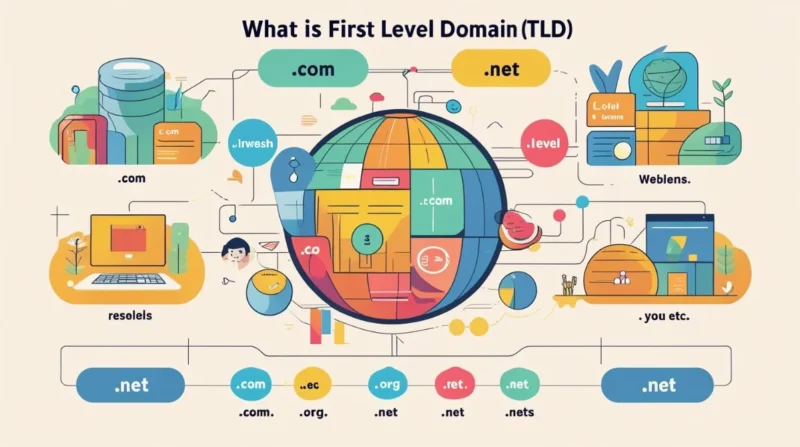Table of Contents
When you type a website address like www.google.comHave you ever noticed the last part that comes after the dot, like .com, .org, or .net? That part is called a first-level domain. Some people also call it a top-level domain or TLD for short.
In this guide, we’ll explain what a first-level domain is, how it works, the different types of TLDs, how it affects SEO, and how you can choose the best one for your website. Whether you’re starting a blog, a business site, or an online store, understanding this small piece of the web address is important.
What Does First-Level Domain Mean?
A first-level domain is the last part of a domain name, the part that comes after the final dot in a web address. For example.
-
In
www.facebook.com.com is the first-level domain. -
In
www.nhs.uk.uk is the first-level domain. -
In
www.harvard.edu.edu is the first-level domain.
It helps classify websites into categories. Some TLDs are meant for specific types of organizations (like .gov for government), while others show the country of the website (like .fr for France or .jp for Japan).
How First-Level Domains Work?
Every website has an address known as a domain name, and that name is connected to a server where the website’s files are stored. The first-level domain is part of that address, helping both people and search engines understand more about the site.
When someone types your domain in their browser, the internet’s Domain Name System (DNS) looks up that name and connects it to your server using the full domain path, which includes the first-level domain. Think of it like a postal code that helps route mail to the right city.
Types of First-Level Domains
There are several types of first-level domains, and they are divided into different categories. Here are the main ones.
1. Generic Top-Level Domains (gTLDs)
These are the most common and widely used domains. Examples include.
-
.comfor commercial websites (most popular worldwide). -
.orgoriginally for non-profit organizations. -
.netfor networks or technical websites. -
.infofor information-based websites. -
.bizfor business use.
Anyone can register these gTLDs, and they are used by all types of businesses, blogs, and personal websites.
2. Country Code Top-Level Domains (ccTLDs)
These represent countries and territories. They’re made up of two letters.
-
.ukUnited Kingdom. -
.caCanada. -
.deGermany. -
.auAustralia. -
.inIndia.
If you’re targeting users in a specific country, using a ccTLD can help build trust and improve local SEO.
3. Sponsored Top-Level Domains (sTLDs)
These are controlled by organizations that set rules about who can use them. Examples include.
-
.edufor educational institutions. -
.govfor U.S. government websites. -
.milfor the U.S. military. -
.jobsfor employment-related sites.
These TLDs are restricted and cannot be used by everyone.
4. New and Custom TLDs
In recent years, many new domain extensions have been introduced, including.
-
.techPopular with technology startups. -
.shopused by e-commerce websites. -
.blogIdeal for bloggers. -
.xyza trendy and generic option.
These give businesses and individuals more options to create brand-specific domain names.
Why First-Level Domains Matter?
Choosing the right TLD is more than just picking what looks good. It plays a role in.
Branding
Your domain is part of your online identity. A good first-level domain makes your site look professional and trustworthy. For example, it It .com is often seen as more reliable than a lesser-known TLD.
Trust
People are more likely to click on and trust domains they are familiar with. While new TLDs can look creative, many users still prefer .com or country-specific domains.
SEO (Search Engine Optimization)
Search engines like Google treat all TLDs equally, but country code domains help your site rank better in local searches. For example, the .fr domain will show up more often in searches from France. However, it’s your content quality, website speed, backlinks, and user experience that have the biggest impact on rankings, not just your domain.
Examples of First-Level Domains in Action
Let’s look at how different websites use TLDs:
-
www.amazon.com:
.comshows it’s a global commercial business. -
www.bbc.co.uk:
.co.ukshows it’s a UK-based company. -
www.stanford.edu:
.edushows it’s an academic institution. -
www.abc.xyz:
.xyzshows a modern, creative web identity.
How to Choose the Right First-Level Domain?
Here are tips to help you pick the best TLD for your website.
1. Choose Familiarity First
If you’re building a business, it .com is usually the safest and most recognizable option.
2. Use ccTLDs for Local Business
If you’re targeting a local audience, using your country’s TLD (like .ca, .in or .ae) can improve trust and search visibility.
3. Be Creative but Clear
New TLDs like .store, .design or It .agency can be useful if they match your brand. Just make sure they’re not too confusing or unfamiliar to your users.
4. Check Availability
Use a domain checker tool to see if your desired domain is available. Try different name variations if your first choice is taken.
5. Avoid Unusual or Spammy TLDs
Some lesser-known TLDs (.zip, .review, etc.) have been misused for spam in the past. Stick with reputable ones to avoid user mistrust.
Fun Facts About TLDs
-
The very first TLDs created were
.com,.org,.net,.gov,.eduand.milin 1985. -
Over 1,500+ TLDs are available today.
-
Google uses
.google,.youtubeand.appall custom TLDs. -
The most registered TLD is still
.com, followed by.netand.org.
Common Mistakes to Avoid
Don’t choose a hard-to-remember or hard-to-spell domain.
Avoid using TLDs that are banned or blocked in some countries.
Don’t rely on TLD alone to rank higher in search results.
Conclusion
The first-level domain is a small but powerful part of your online presence. It not only helps users identify your site but also plays a role in how search engines understand and display it. Whether you choose.coma country code or something more creative, make sure it matches your brand, audience, and goals. The perfect TLD won’t guarantee success, but combined with quality content and smart SEO, it can help set you up for growth. So take your time, do your research, and pick a domain name and extension that you can proudly build on.
Related Topic: What is Bluehost Web Hosting?









